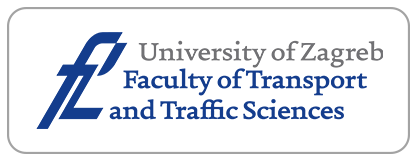Research on Two-Stage Pedestrian Crossing Inductive Signal Control Strategy for Autonomous Intersection

Downloads
Autonomous intersection management (AIM) at “signal-free” intersections under the fully Connected-Automated Vehicle (CAV) environment has become a hotspot. However, few studies show how pedestrians can cross the intersection safely with CAVs. This paper proposes a novel inductive signal control framework considering both pedestrian and CAV demands. This framework consists of two steps. In the first step, a two-stage pedestrian crossing inductive control module for autonomous signal intersections is implemented. In the second step, the CAVs’ trajectories and pedestrian crossing phases are optimised cooperatively. A Mixed Integer Linear Program (MILP) based on conflict-separation is proposed to simultaneously optimise the pedestrian crossing signal phasing scheme and the entry time for CAVs. The goal is to ensure pedestrian crossing safely while optimizing the approaching trajectories of CAVs at the intersection. Numerical experiments are conducted to evaluate the performance and effectiveness of the proposed method under different traffic scenarios. Results show that the proposed method outperforms the signal control mode for pedestrian crossing in one go in terms of reducing average delay under both under-saturated and over-saturated conditions.
Downloads
Dresner KM, Stone P. A multiagent approach to autonomous intersection management. Articial Intelligence Research. 2008;31(3):591-656. DOI: 10.1613/jair.2502.
Li L, Wang FY. Cooperative driving at blind crossings using intervehicle communication. IEEE Transactions on Vehicular Technology. 2006;55(6):1712-1724. DOI: 10.1109/TVT.2006.878730.
Ahmane M, et al. Modeling and controlling an isolated urban intersection based on cooperative vehicles. Transportation Research Part C: Emerging Technologies. 2013;28(3):44-62. DOI: 10.1016/j.trc.2012.11.004.
Carlino D, Boyles SD, Stone P. Auction-based autonomous intersection management. Proceedings of the 16th IEEE International Conference on Intelligent Transportation Systems, 6-9 Oct. 2013, Hague, Netherlands. 2013. p. 529-534. DOI: 10.1109/ITSC.2013.6728285.
Chen X, et al. A nearly throughput-maximum knotted intersection design and control for connected and automated vehicles. Transportation research part B: methodological. 2023;171:44-79. DOI: 10.1016/j.trb.2023.03.005.
Lee J, Park B. Development and evaluation of a cooperative vehicles environment. IEEE Transactions on Intelligent Transportation Systems. 2012;13(1):81-90. DOI: 10.1109/TITS.2011.2178836.
Zhu F, Ukkusuri SV. A linear programming formulation for autonomous intersection control within a dynamic traffic assignment and connected vehicle environment. Transportation Research Part C. 2015;55:363-378. DOI: 10.1016/j.trc.2015.01.006.
Muller ER, Carlson RC, Junior WK. Intersection control for automated vehicles with MILP. IFAC PapersOnLine. 2016;49(3):37-42. DOI: 10.1016/j.ifacol.2016.07.007.
Levin MW, Rey D. Conflict-point formulation of intersection control for autonomous vehicles. Transportation Research Part C: Emerging Technologies. 2017;85:528-547. DOI: 10.1016/j.trc.2017.09.025.
Fayazi SA, Vahidi A. Mixed integer linear programming for optimal scheduling of autonomous vehicle intersection crossing. IEEE Transactions on Intelligent Vehicles. 2018;3(3):287-299. DOI: 10.1109/TIV.2018.2843163.
Lu G, et al. Are autonomous vehicles better off without signals at intersections? A comparative computational study. Transportation Research Part B: Methodological. 2022;155:26–46. DOI: 10.1016/j.trb.2021.10.012.
Chen X, et al. Improved reservation-based method with controllable gap strategy for vehicle coordination at non-signalized intersections. Physica A: Statistical Mechanics and its Applications. 2022;604(1):127953. DOI: 10.1016/j.physa.2022.127953.
Deng Z, et al. Cooperative platoon formation of connected and autonomous vehicles: Toward efficient merging coordination at unsignalized intersections. IEEE Transactions on Intelligent Transportation Systems. 2023;24(5): 5625-5639. DOI: 10.1109/TITS.2023.3235774.
Hao R, et al. Managing connected and automated vehicles with flexible routing at “lane-allocation-free” intersections. Transportation Research Part C: Emerging Technologies. 2023;152:104152. DOI: 10.1016/j.trc.2023.104152.
Amouzadi M, Orisatoki MO, Dizqah AM. Optimal lane-free crossing of cavs through intersections. IEEE Transactions on Vehicular Technology. 2022;72(2):1488-1500. DOI: 10.1109/TVT.2022.3207054.
Hua B, et al. A novel intelligent intersection management scheme focusing on cooperative trajectory planning of connected automated vehicles. IEEE Transactions on Intelligent Vehicles. 2024. DOI: 10.1109/TIV.2024.3401146.
Sun Q, et al. Reducing violation behaviors of pedestrians considering group interests of travelers at signalized crosswalk. Physica A: Statistical Mechanics and its Applications. 2022;594:127023. DOI: 10.1016/j.physa.2022.127023.
Gupta S, Vasardani M, Winter S. Negotiation between vehicles and pedestrians for the right of way at intersections. IEEE Transactions on Intelligent Transportation Systems. 2019;20(3):888–899. DOI: 10.1109/TITS.2018.2836957.
Niels T, et al. Smart intersection management for connected and automated vehicles and pedestrians. 2019 6th International Conference on Models and Technologies for Intelligent Transportation Systems (MT-ITS), 5-7 Jun. 2019, Cracow, Poland. 2019. p. 1-10. DOI: 10.1109/MTITS. 2019.8883362.
Chen R, et al. Stability-based analysis of autonomous intersection management with pedestrians. Transportation Research Part C: Emerging Technologies. 2020;114:463–483. DOI: 10.1016/j.trc.2020.01.016.
El Hamdani S, Benamar N, Younis M. A protocol for pedestrian crossing and increased vehicular flow in smart cities. Journal of Intelligent Transportation Systems Technology Planning and Operations. 2019;24(98):514–533. DOI: 10.1080/15472450.2019.1683451.
Niels T, et al. Optimization-based intersection control for connected automated vehicles and pedestrians. Transportation research record. 2024;2678(2):135-152. DOI: 10.1177/03611981231172956.
Cai P, He J, Li Y. Hybrid cooperative intersection management for connected automated vehicles and pedestrians. Journal of Intelligent and Connected Vehicles. 2023;6(2):91-101. DOI: 10.26599/JICV.2023.9210008.
Mokhtari K, Wagner AR. Pedestrian collision avoidance for autonomous vehicles at unsignalized intersection using deep q-network. ArXiv preprint ArXiv. 2021;2105:00153. DOI: 10.48550/arXiv.2105.00153.
Mokhtari K, Wagner AR. Safe deep q-network for autonomous vehicles at unsignalized intersection. ArXiv preprint ArXiv. 2021;2106.04561.. DOI: 10.48550/arXiv.2106.04561.
Malcolm P, Bogenberger K. Lane-free intersection control for connected automated vehicles prioritizing vulnerable road users. Transportation Research Part C: Emerging Technologies. 2025;170:104918. DOI: 10.1016/j.trc.2024.104918.
Wu W, et al. Autonomous intersection management with pedestrians crossing. Transportation Research Part C: Emerging Technologies. 2022;135:103521. DOI: 10.1016/j.trc.2021.103521.
Jiang H, et al. Pedestrian shuttle service optimization for autonomous intersection management. Transportation Research Part C: Emerging Technologies. 2024;163:104623. DOI: 10.1016/j.trc.2024.104623.
Transportation Research Board(TRB). Highway capacity manual (HCM) 2000. Washington, D C: National Research Council; 2000.
Li L, Wang F. Cooperative driving at blind crossings using intervehicle communication. IEEE Transactions on Vehicular Technology. 2016;55(6):1712–1724. DOI: 10.1109/TVT.2006.878730.
Copyright (c) 2025 Qianyi ZHANG, Xinrui YU, Yugang LIU, Liying TANG

This work is licensed under a Creative Commons Attribution-NonCommercial 4.0 International License.




















